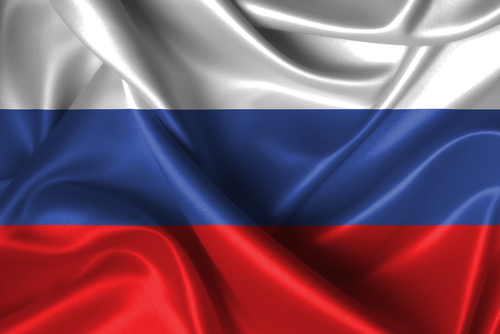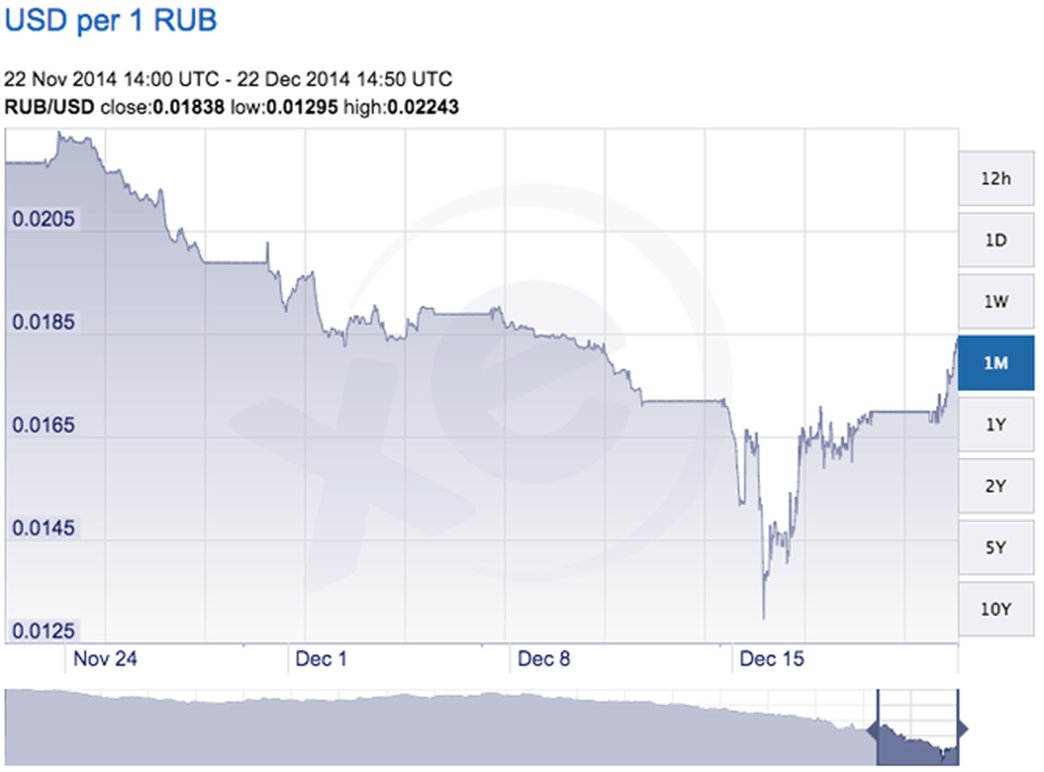The Ruble’s Slide Begins to Claim Banking Casualties

Please note that we are not authorised to provide any investment advice. The content on this page is for information purposes only.
The dramatic slide in the value of the rouble has claimed its first banking casualty. The Russian Central Bank, to the tune of US$530m, is bailing out Trust Bank. The emergency liquidity line’s intent is as life support for one of modern Russia’s more established banks.
The dramatic slide in the value of the rouble has claimed its first banking casualty. The Russian Central Bank, to the tune of US$530m, is bailing out Trust Bank. The emergency liquidity line’s intent is as life support for one of modern Russia’s more established banks.
So much for president Putin’s declaration to the Russian press that “the economy will recover in two years.” The intent of his reassuring message was to stop panic in the currency market and confirm to the public that the Russian government is in control of the unfolding situation (Putin carefully avoided using the word “crisis”). But economic recovery is far from certain and Russia looks set for deeper crisis in 2015.
While the rouble’s downward turn has stopped, it appears this is only a short-term success. The price of money traded between banks in Moscow has shot up in recent days, indicating the loss of confidence in the economy and financial institutions. And there are signs that a larger banking crisis is due to hit the country in early 2015.
Table of Contents
Fragile economic structure
The sliding Russian rouble also heralds a wider collapse of Russia’s fragile economic structure. For the past 15 years, high oil revenues have sustained its growth. In fact, the weaker rouble is only a small part of the economic challenges Putin faces. With oil prices down from their peak in the mid-2000s, Russia’s political-economic model, as well as the social contract between the Kremlin and the population, looks increasingly shaky.
Although not a classic petro-state (unlike some of its oil-producing Middle Eastern counterparts, Russia has a highly skilled work force, a tangible service sector, and the share of value added to its GDP from manufacturing is around 18%, comparable with 17% in Canada), Russia’s place in the BRICS has been firmly anchored in its oil harvest. A major exporter of gas and oil, since 2000 the country has also been expanding its state sector, largely with the help of these revenues.
But, with the price of oil having fallen by 40%, spiralling sanctions over the conflict with Ukraine and a catastrophic decline in investment, Russia’s economic model has come under severe strain. Therefore, while president Putin has said the economy will rebound, it is unclear whether there is any concrete plan of action. With economic pressures mounting and no viable strategy developed at home, an economic collapse now looks unavoidable.
Effect on ordinary Russians
There are two differing views on how the crisis will affect ordinary Russians. On the one hand, many analysts insist that Russia today is very different to the Russia of the 1990s. Its large foreign currency reserves (more than US$400 billion, yet depleting rapidly) suggest that the crisis will have only a moderate effect on economic activity.
Although most people have seen their rouble-denominated incomes halve in the past few months, the financial resources of the Russian state appear healthier than ever. Public debt is low, reserves are high, there is some additional flexibility afforded by the National Prosperity Fund (just shy of US$80 billion in early December, but also depleting). With the lives of the majority of Russians centred on the rouble and domestic economy, the fall in living standards may be unpleasant, but it is not critical. Russians, after all, have lived through many crises and have developed a knack for economic survival.
A serious test
Sceptics like me, on the other hand, believe that despite, or maybe even because of, a more developed economy, this time around the crisis is going to be a serious test for the political regime. Set to escalate after the holiday season in mid-January 2015, the current turmoil brings back the memories of the 1998 debt default, which brought Vladimir Putin to power in the first place. There are several reasons why economic crisis this time will be more destructive.
First, today more channels transmit financial shocks through the economy. Not only do people see the decline in their rouble denominated wages, they also suffer from rising prices. Perhaps most important, a crucial change in the Russian society under Putin has been the rise of the middle class. Since the mid-2000s, Russians have been consuming avidly by taking credit from banks. Starting in January 2015, they will experience their first interest rate shock.
Reacting to new financial controls by the central bank, Russian commercial banks will have to raise the interest on outstanding loans, which will increase the likelihood of people defaulting or falling behind on payments. While it could be easy for individuals to declare bankruptcy, it is the over-extended firms that will spark off a chain of solvency crisis and put further pressure on the banking sector, which has been suffering a crisis since April 2014.
Second, a major channel for crisis transmission is the size of the state itself. In 2005, the Russian budget remained balanced at US$20 per barrel of oil. In 2013, US$102 per barrel balanced the budget. During the recent years of prosperity, the Russian state has expanded its economic presence and today the welfare of many people directly depends on the state’s ability to deliver subsidies.
With shrinking oil revenues and depleting foreign reserves spent on defending the rouble, the budget deficit will need financing through borrowing. However, Russia’s financial credibility – its investment grade rating – is likely to decline, and borrowing will become expensive.
An interim solution lies in the privatisation of some of the state companies (this technique famously created the first generation of oligarchs in 1995-1996). And it is possible that some foreign buyers (for instance, Chinese firms) would be keen to invest in Russia despite the current economic climate and political risks. But such a redistribution of resources is likely to upset the existing oligarchs (some of whom have already lost a lot of money) and open up further tensions among the already divided political elites in Moscow.
Overall, it is quite clear that the political-economic model of Putin’s Russia is facing its greatest challenge to date.
Bank bailouts begin as Russia faces biggest challenge to date is republished with permission from The Conversation UK





